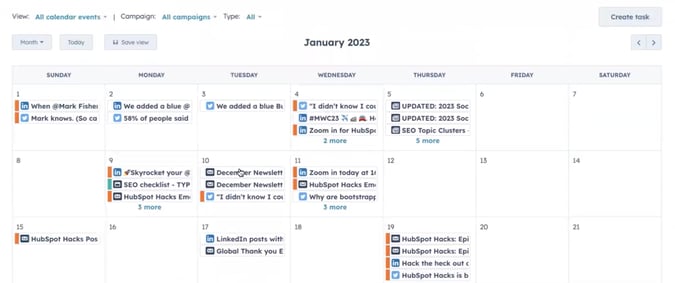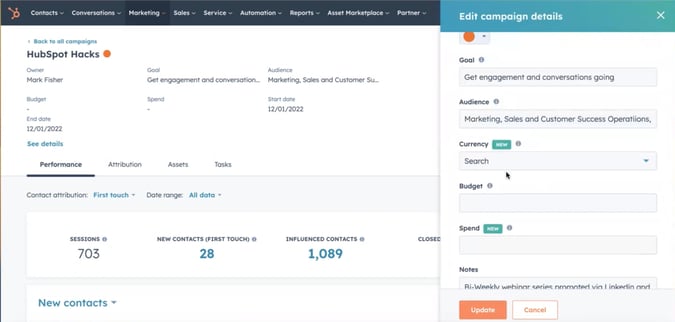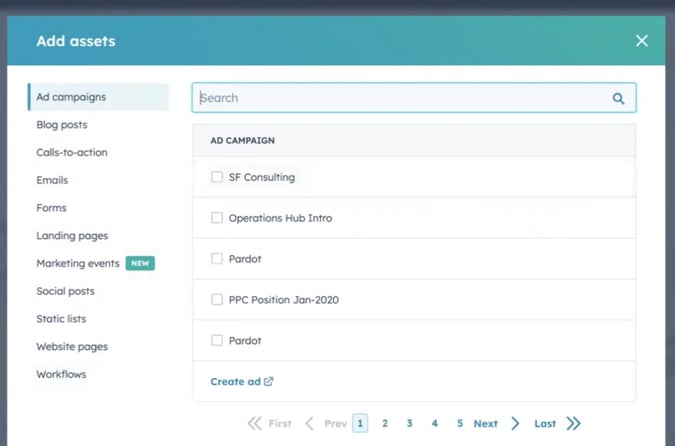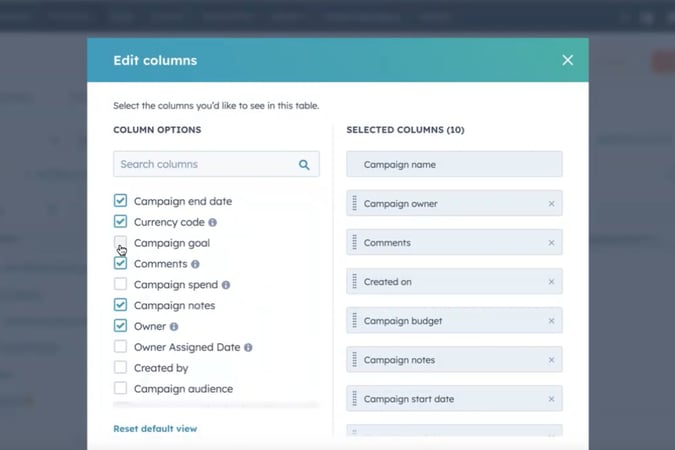
A Hubspot campaign is a group of all the marketing assets related to a certain marketing campaign. Organizing your marketing assets into a campaign has three main benefits.
First, it just makes everything easier! Bundling your assets into a campaign allows you to see everything related to that campaign in one place. You can clone an entire campaign to save a ton of time and energy.
Second, campaigns allow you to focus on working in a process. When you have a campaign set up, you can use the campaign page as a checklist and create your campaign in a step-by-step, organized fashion.
Third, HubSpot campaigns make reporting a breeze. When you look at your analytics at a campaign level, you can see exactly the impact that your campaign had on your overall marketing goals and you can easily measure attribution.
CREATING A CAMPAIGN BRIEF
Before you start building a campaign in HubSpot, you should always create a campaign brief to document the KPI goals what content you will use, what channels you will use to promote your content, and what your budget will be. Here are a few important questions to consider when putting your campaign brief together:
What are the goals of your campaign?
- Is this campaign meant to drive brand awareness? Website traffic? Lead Generation? Reengagement?
- How will success be measured? What KPIs will you use to track the effectiveness of the campaign?
- What is your target audience?
What content will you use to fuel this campaign?
- Will you need to build landing pages? Emails? Videos? Social media? Paid media ads?
How will you promote your content?
- Which channel will perform best?
- Which will allow you to pay for advertisements?
- Which has the best engagement?
- Most importantly, where are your customers spending time together?
What is your campaign budget?
- What is the budget for paid media? (if using paid media channels)
- What is the cost to produce the content?
- What are the agency or freelance costs required to run the campaign? (if any)
- If the campaign is related to a tradeshow or event, what are the costs of a booth, tickets, and travel?
Once your campaign brief is complete, it's time to start building the campaign in HubSpot.
MANAGING HUBSPOT CAMPAIGNS
Customizing Campaign Views
One of the (many) beautiful things about HubSpot Campaigns is that you have the ability to customize your campaign views based on what data you want to see and how you want to manage your work. On the Campaigns page, you can edit columns and pick and choose which data points you want to see as an overview of all your campaigns.
You can also filter the list of campaigns to only see those that fit your specific needs. For example, here are some Campaign Views we love:
- Campaigns started this quarter
- Campaigns that I own
- Campaigns that are trade shows
- Campaigns that ended last month
- Campaigns with a budget over $5,000 (insert your budget amount here)
Using Campaign Calendars
Another thing that is really cool about HubSpot is that you can look at your campaigns in a calendar view. This allows me to get a bird's eye view of what activities are planned for the month.

Looking at your campaigns in the calendar view allows you to see when different assets are scheduled to be published. You can look at all upcoming activities or you can apply filters to the calendar by asset type or campaign. For example, you can isolate what social media posts are scheduled for a specific campaign.
Even better, you can create marketing tasks from the calendar view and assign them to your team. Tasks also appear on the calendar so you can plan your workload to meet campaign deadlines.
Comparing Campaigns
Another unique aspect of HubSpot campaigns is the ability to compare campaigns side-by-side. Let's say you are running a campaign for an annual trade show or event and you ran a similar campaign for last year's event. By going to Compare Campaigns you can compare the performance of this year's campaign to last year's.

By looking at the two campaigns side-by-side you can compare:
- Website sessions generated
- New contacts first touch conversion
- Ad performance
- Email performance
- Contacts influenced
- Deals influenced
- Revenue generated
- And so much more!
CREATING A NEW CAMPAIGN
Creating a new campaign in HubSpot is really easy. All you have to do is go to Marketing-> Campaigns-> Create Campaign and a form will pop up, prompting you to fill out all the campaign details.

PRO TIP: Don't leave the start date blank. While you don't need to populate every field on the campaign form, the start date is really important for reporting. HubSpot won't know how to connect contacts to the campaign if the campaign dates are not populated.
Adding Assets
- Once you have filled out as many details as you can about your campaign, its time to start adding the assets. There are two ways to go about this: You can go to the asset (landing page, email, social post etc.) settings and select the campaign from the dropdown; or
- Add all the assets from the campaign page.
Assets you can add to a campaign:
- Ad Campaigns
- Blog Posts
- Calls-to-action
- Emails
- Forms
- Landing Pages
- Marketing events
- Social Posts
- Static lists
- Website pages
- Workflows

YOUR CAMPAIGN PAGE BECOMES YOUR CHECKLIST
Thanks to the way the campaign page is laid out, you can use the campaign page almost as a project management tool or checklist to be sure that you have created all of the pieces of your campaign. This allows you to focus on working on a process. If your emails are missing from the campaign, you will notice a blank space in the email section and it will remind you to add emails. You can systematically go down the list of assets and make sure you have included everything you need.
CLONING A CAMPAIGN
Let's say you have a series of campaigns that you run on a regular basis like a monthly webinar or a quarterly report. Each time you run one of these campaigns you use the same set of assets: you have a gated landing page, a thank you page, a workflow, three emails, five organic social posts, and two paid ads. Instead of creating each of these pieces from scratch every month, Hubspot enables you to clone the entire campaign. Doing so clones each of the individual assets associated with the campaign so that all you have to do is update each of the cloned assets. Wha-la! So easy!
Plus, it keeps everything standardized and ensures your team is working the same way with every campaign.
MEASURING ROI
Hubspot measures the ROI of a campaign based on the Closed/Won lead status and the revenue reported in the deal record. So, if you close two deals that were generated by the campaign and earned $40,000 from those deals and the campaign cost $10,000, your ROI would be 300%.
Another way of looking at ROI is by measuring the number of deals/ open opportunities the campaign generated. This does not give you a percentage ROI but indicates the potential return on the campaign.
HubSpot campaigns are a real game-changer when it comes to ease of use, working in a process, and simplifying reporting. Having all your campaign assets in one place helps you optimize your campaign for better campaign results.
Learn more about Penguin's Hubspot Implementation services







